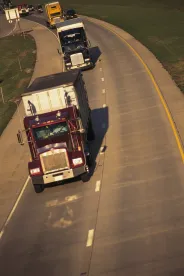Following its final rule for light-duty vehicles issued at the end of 2021, this past spring, the U.S. Environmental Protection Agency (“U.S. EPA”) proposed new emission standards for heavy-duty highway vehicles and engines. Control of Air Pollution from New Motor Vehicles: Heavy-Duty Engine and Vehicle Standards, 87 Fed. Reg. 17,414 (proposed March 28, 2022) (hereinafter the “Proposed Rule”). While U.S. EPA was dealt a blow with respect to its authority to regulate greenhouse gas emissions under the Clean Air Act stationary source program in the U.S. Supreme Court’s recent decision in West Virginia v. EPA, U.S. EPA appears to be continuing its aggressive regulation of emissions in the mobile source space for vehicles and equipment, as evidenced by the Proposed Rule is no exception.
The Proposed Rule builds upon President Biden’s August 2021 Executive Order 14,037 (“Strengthening American Leadership in Clean Cars and Trucks”). To comply with the rule, manufacturers and suppliers will need to plan to meet stringent emission standards beginning with model year 2027 that may require manufacturers to implement more hybrid and zero-emission technologies in their fleets to achieve compliance.
Major Components of the Proposed Rule
U.S. EPA has indicated that the proposed rules for heavy-duty highway vehicles and engines are meant to address emissions, to assist state and local authorities in attainment of required National Ambient Air Quality Standards (“NAAQS”), and to take advantage of and incentivize continued advancements in emission control and zero-emission technologies. In general, the Proposed Rule is aimed at reducing both criteria pollutant and greenhouse gas (“GHG”) emissions from heavy-duty vehicles and engines by addressing three primary categories: (1) implementing a broader range of testing procedures coupled with stricter emissions standards, (2) revising useful life and other associated warranty periods to maintain emissions control standards over a greater period of an engine or vehicle’s operational life, and (3) providing manufacturer incentive programs to meet and exceed proposed emissions standards.
1. Emissions Standards: U.S. EPA’s Proposed Option 1 and Proposed Option 2
For the majority of the provisions included in the Proposed Rule, U.S. EPA is proposing two separate regulatory options (hereinafter “Proposed Option 1” and “Proposed Option 2”) for potential implementation.1 The two options differ not only in the stringency of their emissions standards – Proposed Option 1 is overall more stringent than Proposed Option 2 – but Proposed Option 1 also includes additional steps required for implementation. While Proposed Option 2 includes a single set of emissions standards for all heavy-duty engines and vehicles model year 2027 and later, Proposed Option 1 sets initial emissions standards for model year 2027 to 2030 engines and vehicles, and applies a more stringent set of standards to model year 2031 and later engines and vehicles. In addition, Proposed Option 1 includes longer useful life and warranty periods for heavy-duty engines and vehicles than those proposed under Proposed Option 2. U.S. EPA has indicated that it prefers to pursue Proposed Option 1 due primarily to the lower estimated cost of implementation, greater reduction of criteria pollutants (in particular NOX), and greater monetized health benefits to the public. In comments to the Proposed Rule, manufacturers and other important stakeholders, in general, expressed concern regarding the cost and technological feasibility of implementing Proposed Option 1, recommending U.S. EPA consider the Proposed Option 2 provisions. Commenters also questioned the ability of engine demonstrations to account for real world factors contributing to NOX emissions (thus underestimating actual emissions), the significant cost of developing and installing emissions control technology, and the additional cost to customers of seeking alternatives (such as electric vehicles) to meet the Proposed Option 1 standards.
2. Revisions to Heavy-Duty Engine Regulatory Useful Life and Warranty Periods
In addition to proposing more stringent emissions standards, U.S. EPA is proposing significant extensions to the regulatory useful life standards. In most cases, U.S. EPA’s proposed useful life standards are nearly double that of current standards. In developing the proposed standards, U.S. EPA relied heavily on the California Air Resources Board (“CARB”) Omnibus regulations governing heavy-duty engines. As with the emissions standards, U.S. EPA has proposed two options for regulatory useful life periods with varying standards and implementation stages.
In tandem with proposed increases to regulatory useful life periods for all classes of heavy-duty vehicles, U.S. EPA is also proposing its first significant increase to regulatory emission warranty periods for criteria pollutants since 1983. The standards currently cover between 22 percent and 54 percent of regulatory useful life of an engine or vehicle based on primary intended service class. Under Proposed Option 1, U.S. EPA modeled warranty periods off of those recently promulgated by CARB for their Omnibus program, while Proposed Option 2 includes a minimum extension that would be acceptable for various classes. In doing so, warranty coverage for proposed useful life periods would range from 71 percent to 82 percent of the useful life under Proposed Option 1 and 44 percent to 73 percent of the useful life under Proposed Option 2.
3. Manufacturer Incentive Programs
The Proposed Rule also includes a number of incentive programs for manufacturers for early adoption of proposed standards and even further reductions in emissions. A number of the proposed changes are revisions to existing incentive programs while others are new programs. The U.S. EPA’s Averaging, Banking, and Trading (“ABT”) program for heavy-duty engines, originally established in 1990, has been one mechanism by which the U.S. EPA has instituted progressively more stringent emissions standards. While U.S. EPA has stated that compliance with proposed emissions standards is possible without the use of an ABT program, commenters noted the need for the continued ABT program to achieve compliance. Despite this, U.S. EPA is seeking to limit future production of high emission engines and vehicles and, to that end, is proposing several significant targeted revisions to the ABT program for model year 2027 and later heavy-duty engines and vehicles. U.S. EPA’s proposed revisions regarding the ABT program for heavy-duty engines would prohibit manufacturers from generating ABT credits for a number of pollutants for model year 2027 and later engines and vehicles. These revisions would also prohibit credits generated from previous model years to be applied to model year 2027 and later engines and vehicles.
The Proposed Rule also allows manufacturers of battery electric vehicles (“BEVs”) and fuel cell electric vehicles (“FCEVs”) the option to generate NOX emission credits beginning with model year 2024 vehicles. Considering the expanded opportunities for manufacturers to generate ABT credits through the use of BEVs and FCEVs, U.S. EPA is proposing significant revisions to traditional methods of capping Family Emission Limits. While the Proposed Rule includes various incentives, they are not without limit. The Proposed Rule would limit the life of NOX emission credits for model year 2027 and later engines and vehicles to five years. Banked NOX emission credits using current standards could not be applied to model year 2027 and later engines and vehicles. However, U.S. EPA is proposing implementation of an early adoption incentive program for meeting proposed standards. For model years 2024 to 2026, manufacturers of conventional, hybrid and electric engines and vehicles that demonstrate compliance with model year 2027 or model year 2031 NOX emissions standards would be able to generate additional NOX emission credits for use with engine and vehicle production for the applicable model year.
The Proposed Rule also addresses a number of additional changes and considerations related to adoption of CARB’s Advanced Clean Trucks Program and similar provisions for advancing technologies, provisions related to tampering, durability testing, maintenance, and harmonization of the CARB onboard diagnostic program as well as numerous other technical revisions and updates. The Proposed Rule, if enacted as planned, will likely drive changes throughout the supply chain and further encourage continued moves toward electrification in the heavy-duty space. This will also drive a need for further investments in electric chargers along transportation corridors and at automotive service stations similar to the rules promulgated for light-duty passenger vehicles.
Thank you to co-author Alex Gatlin, a summer associate in Foley's Milwaukee office, for his contributions to this post.
FOOTNOTES
1 U.S. EPA also proposed a third option referred to as “the Alternative” that considers emissions standards more stringent than either Proposed Option 1 or 2. However, U.S. EPA has indicated that additional information is required to determine the feasibility of the Alternative for implementation in the model year 2027 timeframe.





 />i
/>i

